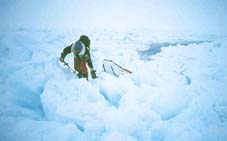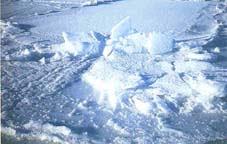|
|
||||||||||||
|
|
|
|
21km
covered on the 11th, 23 on the 12th, and 20 on the 14th: Arnaud and
Rodolphe seem to
have reached a fine cruising speed. On the ice floe - which from now
on is flatter and therefore easier to negotiate - it is not so cold,
-25°C instead of -35°C as it was earlier. We still have no news about
the replacement sledges.
28
km covered on the 9th, and 25 the following day. That's one way of
lifting the two men's spirits. Today, Arnaud and Rodolphe were witness
to a rare phenomenon: the formation of a compression ridge not 20
yards away! The crashing noise was so loud that it was frightening.
The ground trembled. When the two sheets of ice met, they were compressed,
and were smashed by their moving force into creating a wall of ice
with serrated edges. They had the presence of mind to film this natural
happening.
The
cold was becoming ever more intense on the Arctic ice floe, -30°c,
-35°C. For several days, the two men had been sleeping badly and recovering
less quickly from their daytime exhaustion. Their duvets were filled
with ice, which is not easy to bear.
Despite their steadfastly high morale, Arnaud and Rodolphe felt increasingly unsafe because of the presence of bears that more and more frequently came prowling around their tent during the evening and at night. During the night of 22 March, a large female came circling around the encampment yet again. As had now become customary, they fired shots (blanks) into the air, which was enough to frighten the animal off. The next day, Arnaud was up to his waist in the snow that had collected between two enormous blocks of ice. More fear than harm, then. Despite the fact that both his feet slipped and water got into his left shoe. Assessment of 24 March: 230km covered.
Extract from the release : The end of the day was extremely busy: after setting up camp, Arnaud and Rodolphe prepared their meal, entered the number of kilometres covered, examined the map and telephones our base in France to log their report for the day. Suddenly, amid the icy silence of the Arctic Ocean, we could hear strange noises.... Arnaud and Rodolphe recognised the call of the polar bear. Attempting to stay as calm as possible, they poked their head outside the tend and saw, behind them on a block of ice, a bear squatting on its haunches with its front paws in the air. This position indicated that it was about to leap on to the tent. Arnaud and Rodolphe shouted out and used their shovel to frighten him off. The bear then stood up, fixed them with a steely look and then wandered off, nodding its head. How do they protect themselves from bears during the night? By installing an anti-bear fence all round the camp. This is a thin rope strung between four posts, each of which has a smoke-producing rocket that is set off when the rope is moved. Usually, the rocket alerts whoever is sleeping in the tent. Although you wouldn't think so, the fact that the temperatures are high for the season (they have observed temperatures of up to 20°C) is a destabilising factor for the expedition, because it melts the ice, which is also becoming thinner at the same time. Hence the formation of many areas of open water, which helps with access to fish. This is no doubt the reason why there are so many bears - they have already come across five of them. Distance covered by the evening of 19 March: 170 km. 1630 km left to do. During these first few days of their journey, Arnauld and Rodolphe have already had to deal with three major difficulties : stretches of open water, the truly chaotic condition of the ice fields, with hummocks over three metres in height, and the danger associated with encountering polar bears, which seem to be present in this part of the pack ice. Extract from the log : "The bear charged them immediately. Rodolphe had the presence of mind to take the rifle out of the sledge, while Arnaud banged his two skis together to make the maximum amount of noise possible. Seeing that the two travellers had not retreated a single inch, the bear preferred to halt his charge 5 metres from them. Standing on his back legs, he sniffed in the direction of his prey and the marks they had left on the ground. Not recognising the scent of seal, he left the same way he had arrived. The bear was a young male of 400 kg and standing 3 metres (10 feet) tall."
The releases published on their site also provided news of a Danish woman, Betina Aller who left from the same place, Cape Arktikchevsky, with the aim of reaching the pole on her own. But on 7 March, confronted by a bear that would not leave her alone, she had been forced to shoot it. The following day, after unfortunately twisting her knee, she asked to be picked up and taken out. Early problems : the sledges do not like the cutting edges of the blocks of ice and their undersides are cracking. So they contacted Alain Hubert who is having new ones built for them. The new sledges will leave Brussels for Siberia on 22 March.
|




 Another
obstacle : the drifting movement of the pack ice that is pushing them
back the way they came. "It's like a real travelator under our feet,"
said Arnauld on the telephone.
Another
obstacle : the drifting movement of the pack ice that is pushing them
back the way they came. "It's like a real travelator under our feet,"
said Arnauld on the telephone.